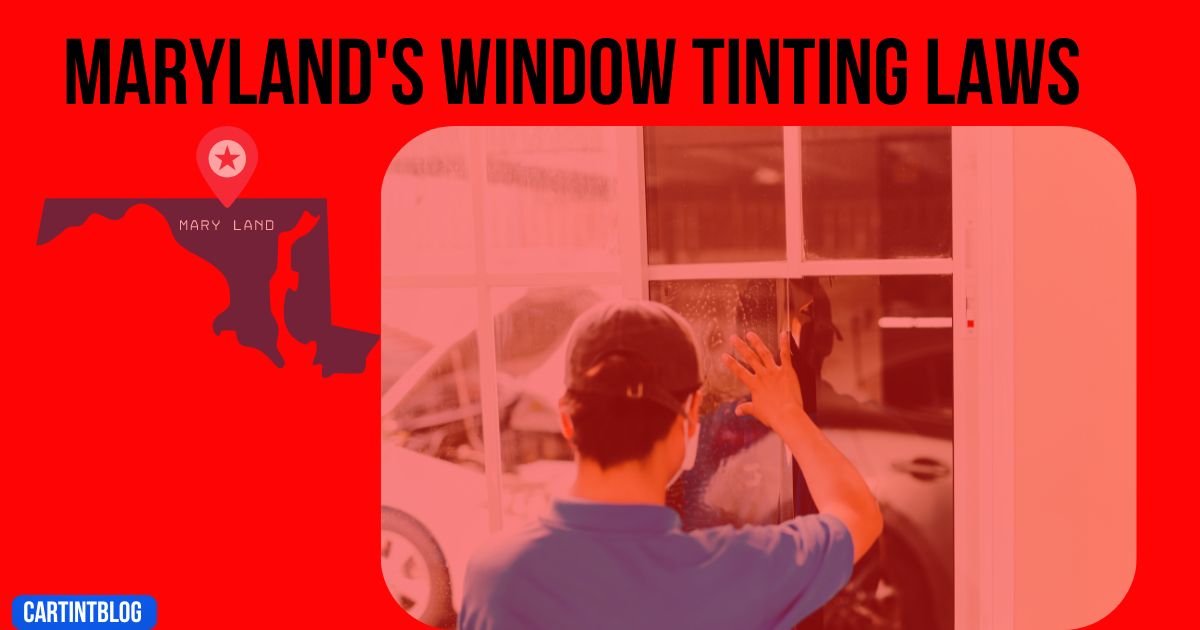Maryland’s window tinting laws regulate the allowable darkness and reflectiveness of vehicle windows. These rules ensure safe driving and promote clear visibility for all drivers on the road. Understanding these regulations can help you avoid fines and ensure your vehicle is compliant. Maryland law specifies different tint limits for different types of vehicle windows.
A Guide To Maryland’s Car Tinting Laws
Understanding Maryland’s car tinting laws is crucial for maintaining compliance and avoiding penalties. These laws are designed to enhance safety and ensure that drivers have clear visibility. Maryland specifies different allowable tint levels for various vehicle windows.
The front side windows must allow more light compared to the rear ones. This distinction helps in ensuring that drivers have a clear view of the road. Knowing these specific tint percentages can help you make informed decisions.
In Maryland, the windshield must remain clear to provide optimal visibility. The law permits only a non-reflective tint along the top five inches of the windshield. This restriction ensures that drivers can see clearly in all lighting conditions.
Regular checks on your window tint can help avoid unnecessary fines. Staying informed about these laws promotes safer driving conditions for everyone. Always consult a professional when applying tint to ensure compliance with Maryland’s regulations.
Navigating Maryland’s Auto Tint Laws: What You Need To Know
Understanding Maryland’s auto tint laws is crucial for keeping your vehicle legally compliant. These regulations specify the allowable darkness for window tints, ensuring clear visibility on the road. For the front side windows, Maryland law permits a minimum of 35% light transmission.
This means at least 35% of outside light should enter the vehicle through these windows. The back side and rear windows can be tinted darker, allowing more privacy. However, the front windshield can only have a tint along the top five inches.
Adhering to these laws helps you avoid fines and ensures a safer driving environment. Law enforcement officers can issue tickets for non-compliant tints, so it’s essential to follow the guidelines.
Consulting a professional before installing tints can help you choose the right shade for your car. Stay informed about these laws, as they can change, affecting what’s legally acceptable. Keeping your tint within legal limits contributes to safer roads for everyone.
Maryland Vehicle Tint Laws: Key Points And Requirements

Maryland’s vehicle tint laws are designed to promote safety and clear visibility on the roads. Understanding these regulations will help you ensure your vehicle’s compliance and avoid penalties. Front side windows must allow more than 35% of light to pass through. Rear side and back windows can have darker tints, Reusable Window Tint but they must meet specific standards.
Reflective tint on windows is prohibited to prevent glare and enhance safety. Medical exemptions are available for those with conditions that require special window tinting. You must carry documentation for these exemptions at all times when driving.
Tint laws apply to all vehicles, including passenger cars, SUVs, and trucks. Enforcement of these laws is strict, and non-compliance can result in fines. Regularly check your vehicle’s tint levels to ensure they meet Maryland’s requirements.
It’s important to keep up-to-date with any changes in the tint laws. Following these regulations not only ensures legal compliance but also promotes safer driving conditions for everyone.
Staying Legal: Maryland’s Rules On Car Window Tints
In Maryland, car window tint laws specify how dark and reflective your vehicle’s windows can be. Understanding these rules is essential to avoid fines and maintain legal compliance. The law allows specific tint percentages for different windows, like the front, side, and rear.
Front side windows must allow over 35% of light through, ensuring clear visibility. The rear windows can be darker, but they must still follow the state’s guidelines. Tinted windows help protect against UV rays and enhance privacy for drivers and passengers.
To stay legal, always check the latest regulations before applying window tint. Professional tinting services can ensure your car meets the state requirements, helping you avoid costly mistakes. Remember, law enforcement officers must see inside your vehicle for safety reasons.
Keeping your windows within the legal limits promotes safer driving conditions for everyone. Regularly review Maryland’s tint laws to ensure your car stays compliant and you enjoy a hassle-free driving experience.
Everything You Need To Know About Window Tinting In Maryland
Window tinting in Maryland comes with specific regulations to ensure safety and visibility. Maryland law limits the darkness of tint on various vehicle windows to promote safer driving conditions. The front side windows must allow at least 35% of light to pass through, while the back side and rear windows have more lenient requirements. These regulations help drivers see clearly and prevent accidents caused by reduced visibility.
The reflectiveness of your tint is also regulated to minimize glare for other drivers. Ensure you use certified tinting films that meet Maryland’s standards to avoid fines. Understanding these rules is crucial before applying window tinting to your vehicle. Always check the latest updates on Maryland’s tinting laws to stay compliant. By adhering to these regulations, you’ll enjoy the benefits of tinting while keeping your vehicle within legal limits.
Maryland’s Tint Law Explained: How Dark Is Too Dark?
Maryland’s tint law focuses on how dark your car windows can be. The state sets specific limits to ensure that window tinting doesn’t impair visibility. For the front side windows, the law requires a minimum of 35% visible light transmission. This means your tint should allow 35% of light to pass through. For the back side windows and rear window, you can use darker tints, but they must still allow enough light for safe driving.
Exceeding these limits can result in fines and the need to remove or alter the tint. Maryland’s law aims to balance privacy and safety, ensuring that drivers have clear visibility. Always check the latest regulations and consult professionals when applying tint to avoid any legal trouble. Staying within these guidelines will help you enjoy your tinted windows without any hassles or penalties.
Complying With Maryland’s Window Tint Standards

Complying with Maryland’s window tint standards is essential for every vehicle owner. The state has specific rules about how dark or reflective your window tint can be. For example, the front side windows need to allow at least 35% of light in. The back side and rear windows have different requirements, often allowing darker tints. By following these rules, you avoid fines and ensure your vehicle is roadworthy.
To comply with Maryland’s standards, always use a reputable tinting service. Check the tint’s legal limits and keep records of your tinting process. Remember, darker tints can lead to visibility issues and potential legal troubles. Regularly inspect your window tint to make sure it meets the state’s regulations. Keeping your tint compliant not only helps you avoid penalties but also ensures a safer driving experience for everyone.
A Closer Look At Maryland’s Automotive Tint Laws
Maryland’s automotive tint laws are designed to balance aesthetics with safety on the roads. These regulations specify how dark or reflective your window tints can be, ensuring that drivers have clear visibility. Front side windows must allow more light in than rear windows to avoid accidents. This helps law enforcement and other drivers see inside the vehicle clearly.
Each vehicle type has its own specific rules regarding window tinting. For instance, the laws differ for passenger cars and SUVs. Understanding these distinctions can help you stay within legal limits and avoid fines.
Always check the latest regulations before applying or changing your window tint. This way, you can enjoy the benefits of tinted windows while remaining compliant with Maryland’s laws. Keep your vehicle both stylish and legal by following these guidelines.
Maryland’s Legal Limits On Car Window Tinting: An Overview
Maryland’s car window tinting laws set specific limits to ensure safety and visibility. The laws specify how dark or reflective your window tint can be. For front side windows, the law allows a maximum tint darkness of 35%. This means that the tint should let in at least 35% of light. The rear side windows and back window can have darker tints, but must comply with state regulations.
Remember, Maryland law requires that tinting on all windows must not reflect more than 35% of light. These limits help prevent issues with visibility and driver safety. If you decide to tint your windows, make sure to check the specific regulations for your vehicle type.
Keeping your tint within legal limits avoids fines and keeps you compliant with Maryland’s safety standards. Always consult local regulations or a professional for the most accurate and current information.
FAQ’s
What Is The Maryland Law On Window Tinting?
Maryland law allows 35% tint on front side windows and darker tints on rear windows, with specific reflectivity limits.
What Medical Conditions Qualify For Window Tint In Maryland?
Conditions like lupus or photosensitivity qualify for medical window tint exemptions. Documentation from a physician is required.
How To Pass Maryland Inspection With Tinted Windows?
Ensure your tint meets legal limits: 35% for front side windows, with no excessive reflectivity, to pass Maryland inspections.
What Is The Darkest Tint You Can Get?
The darkest legal tint in Maryland is 35% for front side windows. Rear windows can be darker, but must follow state regulations.
Conclusion
Understanding Maryland’s window tinting laws helps keep your vehicle compliant and safe. Adhering to these regulations ensures that you avoid fines and complications. Always check the specific limits for front and rear windows to stay within legal bounds. If you need medical exemptions, ensure you have proper documentation. By following these guidelines, you not only adhere to the law but also contribute to safer driving conditions.



